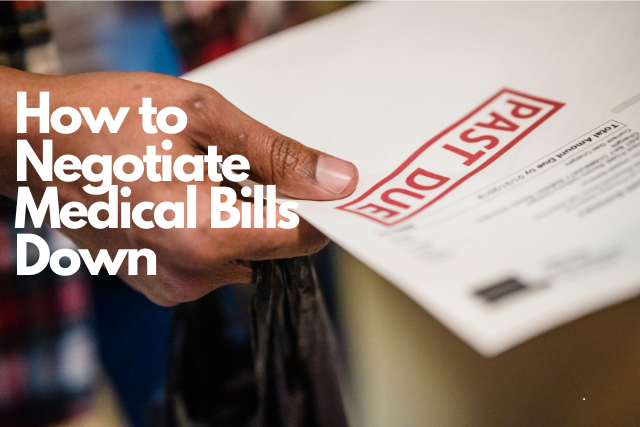How to Negotiate Medical Bills Down: Your Complete Guide
If there is one type of debt I dislike the most, it’s medical debt. 20 million Americans have medical debt, and 14 million have over $ 1,000 or more. The question is, what can you do to manage your finances and pay down these debts?
To negotiate your medical bills down, carefully review your bills for errors, research fair prices for your procedures, and then politely call the billing department to request reductions, financial assistance, or payment plans—often leading to significant savings if you advocate for yourself.
But here’s what the healthcare industry doesn’t advertise: they’re often willing to work with you, especially if you know how to approach the conversation.
Why Medical Bill Negotiation Actually Works
Before we dive into the how, let’s talk about the why. Hospitals and medical providers would rather get something from you than nothing at all. They’re businesses, and they understand that sending your bill to collections means they’ll likely recover pennies on the dollar – if anything.
Think of it this way: would you rather get $2,000 from a patient who pays immediately, or spend months chasing after the full $10,000 with no guarantee you’ll see a dime? Most healthcare providers choose the former, which is exactly where your negotiation power comes from.
The medical billing system is also notoriously complex and error-prone. Studies show that up to 80% of medical bills contain errors, and many procedures are billed at “chargemaster” rates – essentially the sticker price that almost nobody pays. Insurance companies certainly don’t pay these inflated rates, and neither should you.
Disclaimer: Results Not Guaranteed – The information and strategies provided are for educational purposes only and do not constitute medical, legal, or financial advice. We cannot guarantee any specific outcomes or savings amounts regarding medical bill reduction. Success depends on individual circumstances, insurance coverage, and healthcare provider policies. Consult qualified professionals before making decisions about your medical expenses.
Step 1: Don’t Panic – Take Control of Your Medical Bills
When that massive medical bill arrives, your first instinct might be to either pay it immediately or ignore it completely. Both approaches are mistakes. Instead, take a deep breath and remember that you have more power than you think.
Start by organizing everything. Gather all your medical bills, insurance statements, and any correspondence you’ve received. Create a simple spreadsheet or use a notebook to track dates, amounts, and who you’ve spoken with. This organization will be your secret weapon throughout the negotiation process.
Don’t rush to pay. Many people think they need to pay medical bills immediately, but you typically have time to review and negotiate. Most hospitals won’t send bills to collections for at least 90-120 days, giving you a comfortable window to work with.
Step 2: Become a Medical Bill Detective
Before you can negotiate effectively, you need to understand exactly what you’re being charged for. This means becoming a detective and scrutinizing every line item on your bill.
How to Check for Errors on Your Medical Bill
Medical billing errors are incredibly common, and they’re usually not in your favor. Here’s what to look for:
Duplicate charges are probably the most frequent error I see. You might be billed twice for the same procedure, medication, or room charge. Go through your bill line by line and flag anything that seems repeated.
Upcoding happens when you’re charged for a more expensive procedure than what you actually received. If you had a basic consultation but you’re being billed for an extensive examination, that’s upcoding.
Services you never received sometimes make it onto bills. If you see charges for physical therapy sessions you never attended or medications you were never given, dispute them immediately.
Incorrect dates of service can affect your insurance coverage. If the dates don’t match when you received care, it could impact what your insurance will pay.
To verify charges, request itemized bills from your provider. Don’t accept summary statements – you want to see every single charge broken down. Compare these against any notes you took during your visit and your insurance explanation of benefits.
Research Fair Market Prices
Knowledge is power when negotiating medical bills. Before you pick up the phone, research what you should be paying for your procedures. Here’s where those product recommendations come in handy:
Fair Health Consumer provides excellent data on what procedures typically cost in your geographic area. This gives you a baseline for negotiations.
Healthcare Bluebook offers comprehensive pricing information that can help you determine if you’re being overcharged.
ClearHealthCosts provides real-world pricing data from actual patients and providers, which can be invaluable during negotiations.
When you call to negotiate, you can say something like: “According to Healthcare Bluebook, the fair market price for this procedure in our area is $X. Can you explain why I’m being charged significantly more?”
Step 3: Master the Art of Medical Bill Negotiation
Now comes the main event – actually negotiating your medical bills down. This is where many people get intimidated, but remember: the worst they can say is no, and you’re no worse off than when you started.
The Right Mindset for Negotiation
Approach these conversations as problem-solving sessions, not adversarial battles. The person on the other end of the phone likely deals with billing issues all day and wants to help you find a solution. They’re not the enemy – the confusing, overpriced system is.
Be polite but persistent. Remember that the first person you speak with might not have the authority to make significant adjustments. Don’t be afraid to ask to speak with a supervisor or someone in the financial assistance department.
Hospital Bill Negotiation Strategies That Work
Start with the billing department. Call the number on your bill and explain that you’re having difficulty paying and would like to discuss your options. Don’t immediately ask for a discount – instead, ask them to walk you through the charges and explain what financial assistance might be available.
Question everything politely. Ask for explanations of charges that seem high or unclear. Sometimes, simply asking “Can you help me understand this charge?” leads to adjustments without you even asking for them directly.
Mention cash payment. Many providers offer significant discounts for immediate payment. You might say, “If I can pay this bill today, what kind of discount might be available?” Discounts of 10-30% for immediate payment are common.
Reference insurance rates. If you’re uninsured, ask to be charged the same rate that insurance companies pay. This can result in massive savings since insurance companies typically pay much less than the sticker price.
Negotiating Medical Bills After Insurance
Even if you have insurance, you can still negotiate your remaining balance. Insurance doesn’t cover everything, and you might face high deductibles or out-of-network charges.
Review your explanation of benefits carefully. Make sure the provider actually submitted your claim to insurance and that it was processed correctly. Sometimes, bills arrive before insurance has even been contacted.
Question out-of-network charges. Suppose you received care at an in-network facility but got surprise bills from out-of-network providers (like anesthesiologists or radiologists). In that case, you might have grounds to dispute these charges under federal surprise billing laws.
Appeal insurance denials. If your insurance denied coverage for something you believe should be covered, appeal the decision before trying to negotiate with the provider.
| Scenario | Strategy | Typical Outcome |
|---|---|---|
| Uninsured patient | Request insurance rate discount | 40-60% reduction |
| High deductible | Payment plan + discount | 10-25% reduction |
| Out-of-network charges | Appeal + hardship application | 30-70% reduction |
| Billing errors | Itemized review + corrections | 20-50% reduction |
| Emergency care | Charity care application | 50-100% reduction |
Step 4: Explore Financial Assistance and Payment Options
Don’t overlook the various programs designed to help patients manage medical bills. Many people don’t realize that most hospitals are required to offer charity care programs.
Hospital Financial Assistance Programs
Under federal law, nonprofit hospitals must provide charity care to qualifying patients. This isn’t a handout – it’s a legal requirement in exchange for their tax-exempt status.
How to qualify for charity care: Requirements vary, but many programs help patients earning up to 400% of the federal poverty level. For a family of four, that’s about $120,000 annually as of 2024.
What charity care covers: Depending on your income, you might qualify for free care, heavily discounted care, or extended payment plans with no interest.
How to apply: Contact the hospital’s financial counseling department. They’ll walk you through the application process, which typically requires proof of income and assets.
Setting Up Medical Bill Payment Plans
If you can’t get your bill reduced enough to pay in full, most providers will work with you on payment plans.
Interest-free options: Many hospitals offer payment plans with no interest if you make regular payments. This is always better than putting medical bills on credit cards.
Flexible terms: Don’t just accept the first payment plan offered. If they suggest $500 per month and you can only afford $200, negotiate for lower payments over a longer period.
Get agreements in writing: Whatever payment arrangement you agree to, make sure it’s documented in writing. This protects you if there are any misunderstandings later.
Professional Medical Bill Negotiation Services
Sometimes, it makes sense to bring in the professionals. Services like Medical Cost Advocate, Resolve Medical Bills, and Medliminal specialize in negotiating medical bills and can often achieve better results than individuals.
These services typically work on contingency, meaning they only get paid if they save you money. Their fees usually range from 25-35% of the savings they achieve, but they often negotiate reductions that more than cover their costs.
Step 5: Prove Financial Hardship Effectively
If you’re struggling financially, documenting your hardship properly can lead to significant bill reductions or even complete forgiveness.
What Constitutes Financial Hardship
Financial hardship doesn’t just mean you’re broke. Hospitals consider various factors:
- Income relative to expenses: If your basic living expenses consume most of your income, you may qualify for assistance even with a decent salary
- Medical debt burden: Multiple medical bills can constitute hardship even if individual bills seem manageable
- Temporary financial crisis: Job loss, divorce, or other major life changes can qualify you for temporary assistance
- Fixed income situations: Retirees on fixed incomes often qualify for special consideration
How to Document Your Financial Situation
Gather comprehensive documentation. You’ll need recent pay stubs, tax returns, bank statements, and documentation of major expenses like housing, utilities, and other debt payments.
Write a compelling hardship letter. Explain your situation clearly and honestly. Include specific details about what led to your financial difficulties and what you can realistically afford to pay.
Be honest but strategic. Don’t exaggerate your hardship, but do paint a complete picture. Mention any family members you support, ongoing medical conditions that affect your ability to work, or other relevant circumstances.
Sample Hardship Letter Framework
Here’s a basic structure for an effective hardship letter:
Resource: Here is a free financial hardship letter form you can use as well to help you out.
Opening: State your purpose clearly – you’re requesting financial assistance due to hardship.
Background: Briefly explain the medical situation that led to the bills.
Financial situation: Detail your current income, expenses, and why the medical bill creates an undue burden.
Supporting circumstances: Mention any additional factors like job loss, family responsibilities, or ongoing medical needs.
Request: Specify what you’re asking for – whether it’s a payment plan, discount, or charity care consideration.
Closing: Thank them for their consideration and provide your contact information.
Step 6: Leverage Technology and Resources
Modern technology offers several tools to help you navigate medical bill negotiation more effectively.
Apps and Platforms for Bill Management
NogginHQ helps you understand your bills and find financial assistance programs. It’s particularly useful for identifying errors and connecting you with appropriate resources.
Cedar is a patient-facing platform that many providers use for bill management. These often include built-in tools for requesting payment plans or financial assistance.
Dollar For is a nonprofit that specializes in helping patients apply for hospital charity care programs. They can guide you through the application process and help ensure you don’t miss out on available assistance.
Cost Comparison and Verification Tools
Before you negotiate, arm yourself with data from these resources:
GoodRx isn’t just for prescription drugs – they also provide information about procedure costs and can help you understand what you should be paying.
Patient Advocate Foundation offers case management services and can help you navigate both the negotiation process and appeals if your insurance denies coverage.
Community Health Advocates provides free guidance specifically for medical debt situations and can offer strategies tailored to your specific circumstances.
Step 7: Handle Medical Debt Collectors Like a Pro
If your medical bills have already gone to collections, don’t panic. You still have options, and the debt collectors often have even more incentive to negotiate than the original healthcare providers.
Know Your Rights
The Fair Debt Collection Practices Act protects you from abusive collection practices. Debt collectors cannot:
- Call you before 8 AM or after 9 PM
- Contact you at work if you’ve told them not to
- Use threatening or abusive language
- Discuss your debt with third parties
Negotiation Strategies for Collections
Validate the debt first. Request written verification that the debt is legitimate and that the collection agency has the right to collect it. Don’t make any payments until you’ve verified the debt.
Negotiate aggressively. Collection agencies often buy medical debt for pennies on the dollar, giving them significant room to negotiate. Offers of 10-25% of the total amount are often accepted.
Get agreements in writing. Before you pay anything, get the settlement agreement in writing, including confirmation that the debt will be marked as “paid in full” on your credit report.
Special Situations: ER Bills and Emergency Care
Emergency room bills deserve special attention because they’re often the most expensive, and the circumstances of your care may give you additional negotiation leverage.
Negotiate ER Bills Effectively
Question the level of care billed. Emergency rooms often bill for the highest level of care possible. If you were seen quickly and didn’t require extensive treatment, you might be overcharged.
Challenge facility fees. Many ERs charge separate facility fees on top of physician fees. These can often be negotiated or sometimes eliminated.
Review emergency protocols. If you were brought to an out-of-network ER by ambulance or were unconscious, you might be protected by surprise billing laws that limit what you can be charged.
Understanding Emergency Medical Treatment Laws
The Emergency Medical Treatment and Labor Act (EMTALA) requires hospitals to provide emergency care regardless of ability to pay. This doesn’t mean the care is free, but it does give you leverage in negotiations since the hospital was legally required to treat you.
Advanced Negotiation Tactics
Once you’ve mastered the basics, these advanced strategies can help you achieve even better results.
The “Bundle” Approach
If you have multiple bills from the same provider or health system, negotiate them as a package deal. Providers are often more willing to offer significant discounts when they’re settling multiple accounts at once.
Timing Your Negotiations
End of fiscal year: Hospitals often have more flexibility with write-offs and charity care at the end of their fiscal year when they’re trying to meet community benefit requirements.
End of month/quarter: Billing departments may have more authority to make deals when they’re trying to meet collection goals.
Before collections: Once a bill goes to collections, the original provider loses some control over the process. Negotiate before this happens.
Using Multiple Approaches
Don’t put all your eggs in one basket. You might:
- Apply for charity care while also negotiating a cash discount
- Set up a payment plan while appealing insurance coverage
- Work with a professional negotiation service while also exploring assistance programs
| Timeframe | Action Items | Priority Level |
|---|---|---|
| 0-30 days | Review bills, check for errors, organize documents | High |
| 30-60 days | Research fair pricing, initial negotiation calls | High |
| 60-90 days | Apply for financial assistance, set up payment plans | Medium |
| 90+ days | Finalize agreements, consider professional help | High |
What to Do When Negotiations Stall
Sometimes, despite your best efforts, negotiations don’t go as planned. Don’t give up – you have additional options.
Escalation Strategies
Request a supervisor. The first person you speak with may not have the authority to make significant adjustments. Politely ask to speak with someone who can make decisions about your account.
Contact patient advocacy. Most hospitals have patient advocates who can help resolve billing disputes. They often have more flexibility than standard billing department staff.
Reach out to the administration. Hospital administrators care about their institution’s reputation. A well-written letter explaining your situation and your attempts to resolve it can sometimes unlock solutions that weren’t previously offered.
When to Consider Professional Help
If you’re dealing with very large bills (over $10,000), complex insurance issues, or if you’re not comfortable negotiating on your own, professional help might be worth the cost.
Medical billing advocates specialize in exactly these situations and often achieve results that justify their fees. They understand the system inside and out and can navigate complex billing issues that might overwhelm individual patients.
Healthcare attorneys might be necessary if you suspect fraud, discrimination, or if you’re dealing with liens or garnishments related to medical debt.
Protecting Your Credit During the Process
While you’re negotiating, it’s important to protect your credit score and prevent additional financial damage.
Communication is Key
Stay in regular contact with your healthcare providers throughout the negotiation process. Even if you can’t pay the full amount immediately, showing a good faith effort to resolve the situation can prevent them from sending your account to collections.
Document Everything
Keep detailed records of every conversation, including:
- Date and time of the call
- Name of the person you spoke with
- Summary of what was discussed
- Any agreements or next steps
This documentation can be invaluable if there are disputes later or if you need to escalate your case.
Monitor Your Credit Report
Check your credit report regularly during this process. If medical bills do appear on your credit report, you have rights under the Fair Credit Reporting Act to dispute inaccurate information.
The Psychology of Medical Bill Negotiation
Understanding the human element of medical bill negotiation can significantly improve your results.
Building Rapport
Remember that the people you’re dealing with are just doing their jobs. They’re not personally responsible for high healthcare costs, and they’re often genuinely trying to help patients find solutions.
Be respectful and patient. Even when you’re frustrated with the system, maintain a professional demeanor with individual staff members.
Share your story. People connect with personal stories. Briefly explaining your situation can help billing representatives understand why you need assistance.
Express appreciation. Thank people for their time and help, even if they can’t give you everything you want. This builds goodwill and may make them more willing to help you find alternative solutions.
Managing Your Own Expectations
Negotiation is rarely a one-call solution. Be prepared for multiple conversations and don’t get discouraged if your first attempt doesn’t yield the results you want.
Set realistic goals. While dramatic reductions are possible, don’t expect every bill to be cut by 90%. Sometimes, a 20% reduction and a reasonable payment plan is a good outcome.
Be prepared to compromise. Successful negotiation usually involves give and take. You might not get the lowest possible price, but you might get favorable payment terms.
Looking Forward: Preventing Future Medical Bill Surprises
While you’re dealing with current medical bills, it’s worth thinking about how to avoid similar situations in the future.
Before Your Next Medical Procedure
Get estimates in writing. Ask for detailed cost estimates before any non-emergency procedures. This helps you budget and gives you negotiation power if the final bill is significantly higher.
Verify network status. Make sure all your providers are in your insurance network. This includes not just your primary doctor, but also any specialists, anesthesiologists, or facilities involved in your care.
Understand your insurance benefits. Know your deductible, out-of-pocket maximum, and coverage limitations before you need care.
Building Your Medical Bill Emergency Fund
Consider setting aside money specifically for medical expenses. Even a small emergency fund can give you more negotiation power since you can offer immediate payment for discounts.
Your Action Plan: Next Steps for Medical Bill Success
Now that you’re armed with all this information, here’s your roadmap to successfully negotiating your medical bills:
Week 1: Organize all your medical bills and insurance documents. Check each bill carefully for errors and research fair pricing for your procedures.
Week 2: Make your initial calls to providers. Focus on understanding the charges and exploring available assistance programs.
Week 3: Apply for any financial assistance programs you might qualify for. Follow up on any payment plan discussions from the previous week.
Week 4: Finalize your negotiation strategy based on the responses you’ve received. If necessary, escalate to supervisors or consider professional help.
Remember, medical bill negotiation isn’t just about saving money – it’s about taking control of your healthcare finances and refusing to let medical debt derail your financial future.
The key to successful medical bill negotiation is persistence, preparation, and the understanding that you have more power than you think. The healthcare system may be complex and sometimes intimidating, but it’s also filled with people who want to help you find solutions.
Don’t let embarrassment or intimidation keep you from advocating for yourself. Every dollar you save through negotiation is a dollar that stays in your pocket, and every successful negotiation makes you better prepared for any future medical bills that come your way.
Your health is priceless, but that doesn’t mean your medical bills have to be. Take control, ask questions, and negotiate with confidence. You’ve got this.
Ready to tackle those medical bills? Start with the easiest wins first – check for obvious errors and make that first phone call to your provider’s billing department. Remember, the worst they can say is no, but you might be surprised by how willing they are to work with you.





